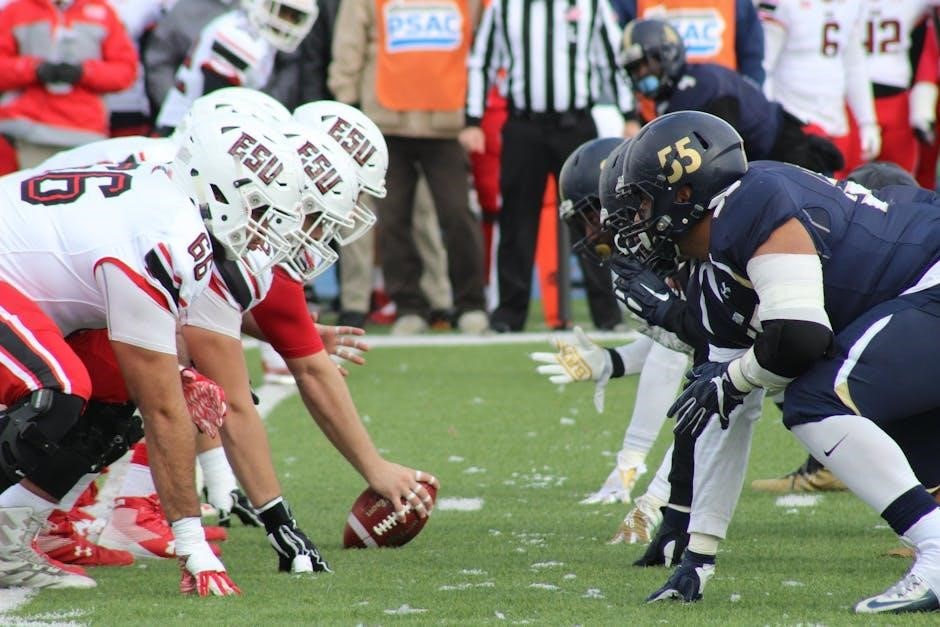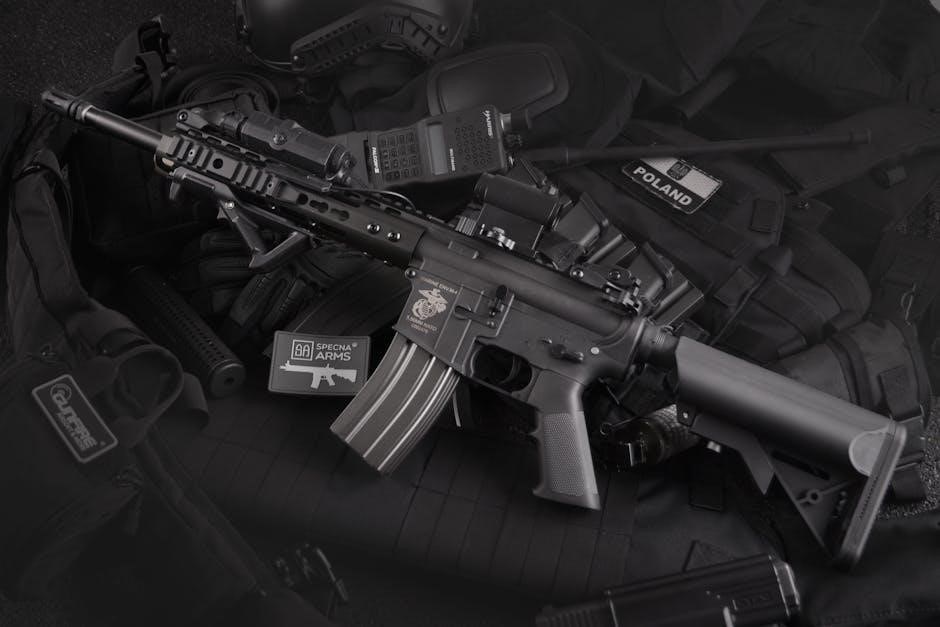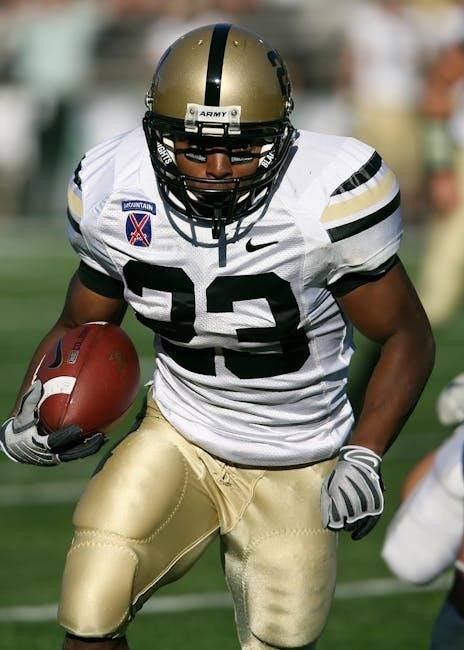Offense Playbook PDF: A Comprehensive Guide
The offensive playbook is diverse‚ containing over 150 team
playbooks. This playbook is a comprehensive offensive system with over
400 pages. Don’t panic. We will walk through it step by step.
Practicing the fundamentals is crucial.
An offensive playbook is a critical tool for any football team‚ serving
as a comprehensive guide to the team’s offensive strategies and plays.
It includes plays for both passing and running‚ outlining different
formations and schemes. Coaches utilize the playbook to craft game
plans for each opponent.
The best offensive teams combine diverse passing and running plays to
make their scoring strategy unpredictable. Strong playbooks have a play
for every situation‚ exploiting the weaknesses of the opposing team. It
is easier to call the right play at the right time if your playbook has
a specialty for a particular scenario.
A well-designed playbook evolves throughout a season. It’s better to have
fewer plays and execute them well than to run everything and be
ineffective. Playbooks should ensure offensive and defensive teams are
aligned to identify and correct any problem areas. The playbook is the
foundation of every strategy.
Key Components of an Offensive Playbook
A comprehensive offensive playbook typically includes several key
components. First‚ it details various offensive formations‚ such as Ace‚
Pistol‚ Shotgun‚ and goal-line sets‚ each designed for specific
situations and personnel. The playbook outlines individual play diagrams
for both passing and running plays‚ providing precise instructions for
each player’s role and responsibilities.
Passing game strategies form a crucial part‚ including route combinations‚
coverage reads‚ and pass protection schemes. Running game strategies are
equally important‚ detailing blocking schemes like zone and gap blocking‚
as well as different running plays‚ such as dives‚ sweeps‚ and traps.
The playbook should also include terminology and play-calling procedures‚
ensuring clear communication among players and coaches.
Effective playbooks also incorporate adjustments and counters to common
defensive strategies‚ allowing the offense to adapt during the game.
Finally‚ a good playbook emphasizes the fundamentals of the offense‚
ensuring players understand the core principles and can execute them
efficiently.
Passing Game Strategies in the Playbook

The passing game section of an offensive playbook is crucial‚ outlining
various strategies to effectively move the ball through the air. It begins
with detailed route combinations designed to exploit defensive weaknesses‚
such as crossing routes‚ deep crosses‚ slants‚ and play-action passes. The
playbook specifies receiver option routes‚ contingent on defensive
alignment‚ requiring quarterbacks to accurately read coverage.
Pass protection schemes are essential‚ ensuring the quarterback has
sufficient time to make reads and deliver the ball; These schemes detail
blocking assignments for offensive linemen and running backs‚ accounting
for different defensive pressures. The playbook includes rules for
quarterback reads‚ enabling quick and informed decisions based on
defensive formations.
Adjustments to counter specific defensive tactics are also key‚ such as
altering routes or protection schemes against blitzes or zone coverages.
The passing game strategy emphasizes practicing the fundamentals of passing
and catching‚ ensuring efficient execution. Quick-read short passes and
shallow crosses are incorporated to extend drives and maintain possession.
Running Game Strategies in the Playbook
The running game section of an offensive playbook details diverse strategies
to establish a ground attack. It includes various run schemes such as zone
running‚ gap running‚ power runs‚ and trap plays designed to exploit
defensive alignments. Blocking schemes are crucial‚ specifying angles and
assignments for the offensive line to create running lanes. Playbooks
often feature plays like “Orange 26” as foundational runs.
The playbook highlights the importance of identifying defensive weaknesses‚
such as a soft defensive line‚ to leverage tight ends for enhanced
blocking. Against aggressive defenses‚ trap plays are utilized to gain
better blocking angles. Dive and sweep plays are effective against reading
defenses.
The strategies also emphasize the importance of the offensive line working
in unison‚ with smaller linemen relying on angles for effective blocking.
The running game often utilizes formations like Ace‚ Pistol‚ and Shotgun‚
positioning the quarterback under center for play-action opportunities.
The running game should force defensive adjustments‚ like shifting to more
man coverage.
Offensive Formations and Their Applications
The offensive playbook dedicates a section to various formations‚ each
designed for specific scenarios. Formations such as Ace‚ Pistol‚ Shotgun‚
and Wishbone are detailed‚ outlining player positioning and their
applications. Ace formations‚ with a single back‚ offer versatility based
on talent and game situation‚ often featuring the quarterback under
center. Pistol formations blend shotgun and single-back elements‚ enabling
quick reads and a running back with momentum.
Shotgun formations are prevalent‚ particularly in spread offenses‚ allowing
for quick passes and spreading the defense. The playbook explains how
multiple formations‚ including those with four or five receivers‚ can
overwhelm defenses. Goal Line and Wildcat formations are included for
short-yardage situations. Formations are chosen to exploit mismatches‚
dictating defensive responses.
Coaches use the playbook’s formation section to adapt game plans‚
utilizing strengths. Formations are selected based on defensive
alignments‚ such as motion from wide receivers. Adjustments are made to
gain advantages‚ like running plays against lighter defensive back
formations. Formations can also be shifted to create vertical seams for
the running game.
Pro Style Offense: Exploiting Defensive Weaknesses
The Pro Style offense in a playbook focuses on exploiting a team’s
weaknesses. If a team has a weak defensive line‚ the playbook will likely
utilize tight ends to create an advantage in running the ball. Conversely‚
if the opposing team has a strong defensive line‚ the Pro Style offense
can spread the field with multiple wide receivers to create passing
opportunities.
Formations like Ace are common‚ with a single back and the quarterback
under center‚ allowing for effective play-action passes. The Pro Style
offense is designed to be adaptable‚ using various formations depending on
the talent available and the specific game situation. This offensive style
requires a balanced offensive line‚ a quarterback with good decision-making
skills‚ and a running back capable of running between the tackles.
The playbook will outline strategies for identifying and attacking
defensive vulnerabilities. This might include adjusting formations‚ running
specific plays based on defensive alignment‚ and utilizing play action to
capitalize on aggressive defenses. The goal is to create mismatches and
exploit weaknesses‚ leading to consistent gains and scoring opportunities.
The Pro Style offense emphasizes a balanced attack‚ keeping the defense
guessing and maximizing offensive potential.
Air Raid Offense: The Passing Powerhouse

The Air Raid offense‚ a shotgun spread‚ pass-first scheme‚ emphasizes
putting up yards and points. It’s known for its extensive passing plays.
While primarily pass-focused‚ the Air Raid necessitates the ability to read
defenses‚ particularly within the box. You can audible to a run play or
use quick-read short passes to extend the run when the defense overcommits
to the pass.
The Air Raid’s success hinges on having multiple wide receivers‚ an
accurate quarterback‚ and a shifty running back. Utilizing plays like
shallow crosses and all slants applies constant pressure on the defense.
This playbook excels at moving the ball downfield quickly through a short‚
rapid passing game.
The Run and Shoot will have option routes‚ so the better you read defenses‚
the better you will succeed in the passing attack. The Air Raid offense is
a complex and challenging offense to run for the quarterback as they have
to be able to predict where the receivers will break off their routes
depending on their options.
Spread Option Offense: Mismatches and Versatility
The Spread Option offense thrives on creating mismatches and maintaining
versatility. This scheme combines elements from pass-heavy offenses like
the Run and Shoot‚ utilizing three or more wide receivers‚ with the
isolation principles found in option offenses. This allows the offense to
spread the defense horizontally‚ forcing them to defend the entire field.
The Spread Option is a quarterback-friendly offense‚ offering quick reads
and simplified play calling. With the potential to put numerous weapons on
the field‚ this playbook can overwhelm defensive players. Zone reading and
play-action passes are crucial for this offense’s effectiveness. The
constant motion makes it difficult for defenses to keep up‚ creating
confusion and opportunities for big plays.
The Spread Option can keep the defense guessing while allowing you to rack
up many yards and points. The playbook offers multiple sets from Pistol‚
Shotgun‚ and even Wildcat formations. The Spread Option likes to create
mismatches‚ and Todays game of football is all about mismatches.
Multiple Offense: Combining Schemes for Unpredictability
The Multiple Offense combines various offensive schemes to capitalize on a
team’s strengths‚ making it unpredictable for opposing defenses. This
approach allows for attacking the field from diverse formations‚ such as
spreading the field with four or five receivers or utilizing fullbacks and
tight ends to bolster the running game. The key is adaptability‚ using
elements from Air Raid‚ Spread Option‚ and Pro Style concepts.
The primary benefit of the Multiple Offense is the difficulty it presents
for defenses in scouting and predicting upcoming plays. This constant
variation keeps them off balance and prevents them from keying in on any
single strategy. However‚ the downside is that a team might become
mediocre in many areas rather than excelling in one particular style. The
success of this playbook relies heavily on the team’s talent and ability
to execute diverse plays effectively.
The playbook offers numerous options‚ potentially overwhelming defenses if
the team possesses the talent to fully utilize it. Formations like Pistol
and the Wishbone can be incorporated for added versatility. While recruiting
might be more challenging due to the need for diverse skill sets‚ it can
also be more enjoyable‚ as it allows for building a well-rounded team.
Power Spread Offense: A Physical Approach
The Power Spread Offense combines the principles of spread offenses with a
physical‚ downhill running game. It spreads the defense while maintaining a
strong emphasis on an effective running attack‚ making it versatile and
challenging to defend. This offense utilizes a multitude of screens and
quick passes to keep the defense guessing‚ creating favorable matchups and
opportunities for big plays.
Smaller schools can particularly benefit from the Power Spread by employing
smaller‚ more agile offensive linemen who excel at blocking on angles. This
approach allows them to compensate for a lack of size with technique and
athleticism. A key advantage of the Power Spread is its ability to adapt
formations and tempo‚ stressing defenses and forcing them to adjust
constantly.
Unlike finesse-based spread offenses‚ the Power Spread is a tough‚ physical
approach that emphasizes a strong running game. Teams like the Ohio State
Buckeyes‚ Oregon Ducks‚ and Clemson Tigers exemplify this approach.
Recruiting top offensive talent is crucial for success in this system‚
ensuring the team has the necessary skill players to execute the playbook
effectively. The Power Spread provides a balanced attack that can exploit
defensive weaknesses both on the ground and through the air.
Veer and Shoot Offense: Stretching the Defense
The Veer and Shoot offense‚ popularized by Art Briles‚ is designed to
stretch defenses horizontally‚ creating one-on-one matchups and exploiting
space. This offense utilizes massive splits between receivers‚ forcing
defenses to cover the entire width of the field. The goal is to create
favorable matchups for skilled receivers‚ allowing them to make plays in
space.
The Veer and Shoot incorporates both gap and zone running schemes‚ providing
versatility in the ground game. Zone running schemes are particularly
effective‚ making it challenging for defenses to defend. This often forces
defenses to switch to a more man-to-man style‚ which allows the offense to
target specific players and exploit mismatches.
The offense is a zone killer that pressures the defense into predictable
coverages. Ole Miss and TCU are examples of teams that effectively
utilize the Veer and Shoot. If you want to force your online opponent to quit
in the first quarter‚ the Veer and Shoot is your playbook. This style
requires great receiver talent and a good quarterback.
Triple Option Offense: The Art of Deception
The Triple Option offense is a classic‚ old-school approach to football‚ known
for its deception and emphasis on fundamental execution. Military academies
like Army‚ Air Force‚ and Navy are renowned for running this offense almost
exclusively. It relies on precise assignments and flawless execution to
mislead the defense. In its heyday‚ teams like Oklahoma and Nebraska dominated
with their effective option play.

With a revamped pitch mechanic‚ mastering the option can give defensive
players headaches. The threat of the quarterback run‚ the pitch‚ and the
dive creates constant uncertainty for defenders. The triple option can frustrate
opponents‚ potentially leading them to overcommit and opening up
opportunities for big plays.
The success of the Triple Option hinges on discipline and precision.
Teams must practice the fundamentals repeatedly to execute the plays
effectively. This offense is all about deception‚ making it difficult for
defenses to anticipate the point of attack. A good use of the fake pitch will
juke someone as you roll.
Pistol Offense: Hybrid Approach for Dual-Threat Quarterbacks
The Pistol offense‚ popularized by Chris Ault at Nevada‚ blends elements of
the shotgun and single-back formations‚ creating a hybrid approach that
pressures defenses. This offensive style provides quarterbacks with quick
reads and simplifies play calling. It also allows you to put a number of
weapons on the field‚ this playbook is overwhelming for the defensive players
to stop.
The Pistol formation offers quarterbacks the schematic advantages of the
shotgun while allowing running backs to build momentum like in a traditional
I-formation. This formation works exceptionally well with dual-threat
quarterbacks. Be sure you look for that type of player when recruiting for
your team.
The Pistol offense is a quarterback-friendly system that relies on quick
decision-making and accurate passing. It allows for a balanced attack‚
combining a strong running game with effective passing plays. The Pistol
still gives you the schematic advantages of the Shotgun.

This offense provides your quarterback a chance to make reads downfield and
let the running back gain momentum like a traditional I formation offense.
Utilizing a hybrid Shotgun and single-back formation‚ it started a craze for
offensive coaches.
